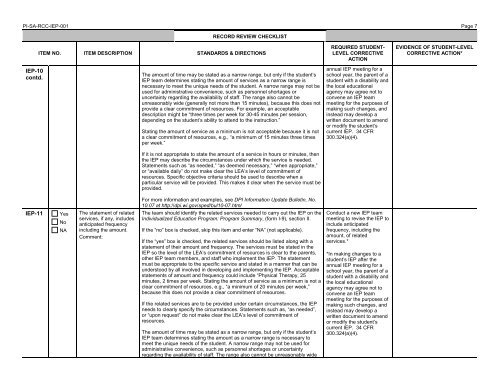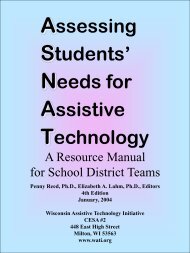procedural compliance self-assessment - The Special Education Team
procedural compliance self-assessment - The Special Education Team
procedural compliance self-assessment - The Special Education Team
You also want an ePaper? Increase the reach of your titles
YUMPU automatically turns print PDFs into web optimized ePapers that Google loves.
PI-SA-RCC-IEP-001 Page 7<br />
IEP-10<br />
contd.<br />
IEP-11<br />
RECORD REVIEW CHECKLIST<br />
ITEM NO. ITEM DESCRIPTION STANDARDS & DIRECTIONS<br />
Yes<br />
No<br />
NA<br />
<strong>The</strong> statement of related<br />
services, if any, includes<br />
anticipated frequency<br />
including the amount.<br />
Comment:<br />
<strong>The</strong> amount of time may be stated as a narrow range, but only if the student’s<br />
IEP team determines stating the amount of services as a narrow range is<br />
necessary to meet the unique needs of the student. A narrow range may not be<br />
used for administrative convenience, such as personnel shortages or<br />
uncertainty regarding the availability of staff. <strong>The</strong> range also cannot be<br />
unreasonably wide (generally not more than 15 minutes), because this does not<br />
provide a clear commitment of resources. For example, an acceptable<br />
description might be “three times per week for 30-45 minutes per session,<br />
depending on the student’s ability to attend to the instruction.”<br />
Stating the amount of service as a minimum is not acceptable because it is not<br />
a clear commitment of resources, e.g., “a minimum of 15 minutes three times<br />
per week.”<br />
If it is not appropriate to state the amount of a service in hours or minutes, then<br />
the IEP may describe the circumstances under which the service is needed.<br />
Statements such as “as needed,” “as deemed necessary,” “when appropriate,”<br />
or “available daily” do not make clear the LEA’s level of commitment of<br />
resources. Specific objective criteria should be used to describe when a<br />
particular service will be provided. This makes it clear when the service must be<br />
provided.<br />
For more information and examples, see DPI Information Update Bulletin, No.<br />
10.07 at http://dpi.wi.gov/sped/bul10-07.html<br />
<strong>The</strong> team should identify the related services needed to carry out the IEP on the<br />
Individualized <strong>Education</strong> Program: Program Summary, (form I-9), section II.<br />
If the “no” box is checked, skip this item and enter “NA” (not applicable).<br />
If the “yes” box is checked, the related services should be listed along with a<br />
statement of their amount and frequency. <strong>The</strong> services must be stated in the<br />
IEP so the level of the LEA’s commitment of resources is clear to the parents,<br />
other IEP team members, and staff who implement the IEP. <strong>The</strong> statement<br />
must be appropriate to the specific service and stated in a manner that can be<br />
understood by all involved in developing and implementing the IEP. Acceptable<br />
statements of amount and frequency could include “Physical <strong>The</strong>rapy, 25<br />
minutes, 2 times per week. Stating the amount of service as a minimum is not a<br />
clear commitment of resources, e.g., “a minimum of 20 minutes per week,”<br />
because this does not provide a clear commitment of resources.<br />
If the related services are to be provided under certain circumstances, the IEP<br />
needs to clearly specify the circumstances. Statements such as, “as needed”,<br />
or “upon request” do not make clear the LEA’s level of commitment of<br />
resources.<br />
<strong>The</strong> amount of time may be stated as a narrow range, but only if the student’s<br />
IEP team determines stating the amount as a narrow range is necessary to<br />
meet the unique needs of the student. A narrow range may not be used for<br />
administrative convenience, such as personnel shortages or uncertainty<br />
regarding the availability of staff. <strong>The</strong> range also cannot be unreasonably wide<br />
REQUIRED STUDENT-<br />
LEVEL CORRECTIVE<br />
ACTION<br />
annual IEP meeting for a<br />
school year, the parent of a<br />
student with a disability and<br />
the local educational<br />
agency may agree not to<br />
convene an IEP team<br />
meeting for the purposes of<br />
making such changes, and<br />
instead may develop a<br />
written document to amend<br />
or modify the student’s<br />
current IEP. 34 CFR<br />
300.324(a)(4).<br />
Conduct a new IEP team<br />
meeting to revise the IEP to<br />
include anticipated<br />
frequency, including the<br />
amount, of related<br />
services.*<br />
*In making changes to a<br />
student’s IEP after the<br />
annual IEP meeting for a<br />
school year, the parent of a<br />
student with a disability and<br />
the local educational<br />
agency may agree not to<br />
convene an IEP team<br />
meeting for the purposes of<br />
making such changes, and<br />
instead may develop a<br />
written document to amend<br />
or modify the student’s<br />
current IEP. 34 CFR<br />
300.324(a)(4).<br />
EVIDENCE OF STUDENT-LEVEL<br />
CORRECTIVE ACTION*











